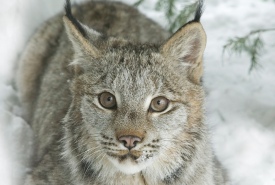
Canada lynx (Photo courtesy of Darlene Stack)
Canada lynx
Where does this species live?
The Canada lynx can be found in intact forests of Canada and the U.S. (Alaska). Its distribution stretches south of the Canadian border through the Rocky Mountains, and also in states surrounding the Great Lakes and northern New England.
What do they look like?
These seldom seen creatures are smaller than cougars and slightly larger than bobcats.
Canada lynx have long tufts of fur on their ears, and longer back legs than the bobcat. Their large paws are covered in thick, coarse hair. Their toes spread out and function much like snowshoes.
These large paws allow the species to live in a more northerly habitat than the bobcat. This allows Canada lynx to hunt in deep snow, which reduces competition for food. Since the Canada lynx cannot run fast, it must stalk and ambush from a close distance.
What is their conservation status?
Populations are lowest in its U.S. distribution and in the Atlantic provinces of Nova Scotia and New Brunswick where the Canadian lynx is listed as imperilled for Nova Scotia, vulnerable in Newfoundland (just the island), and is apparently secure in New Brunswick and rest of Canada. For more information on the conservation status of Canada Lynx in your area or U.S., visit the NatureServe Explorer website.
What is NCC doing to protect habitat for this species?
One of the ways the Nature Conservancy of Canada (NCC) is addressing the habitat needs for lynx is through the completion of a Natural Area Conservation Plan (NACP) for the Restigouche watershed in northern New Brunswick and Quebec. NACPs are designed to highlight critical ecosystems and species of a particular area and outline actions that are needed to protect the plants and animals that live there.
The Restigouche watershed is a natural corridor that lies in the middle of the Appalachian Mountain Range in northern New Brunswick, next to Quebec and separated by the Restigouche River. This area sprawls over more than 6,000 square kilometres. It is a critical corridor for species such as Canada lynx.
Conservation in the Restigouche Corridor Natural Area will help NCC protect the critical corridors for wide-ranging mammals such as Canada lynx.
For more information on Canada lynx, please visit:
How you can help
Want to support wildlife species and their habitat? With your donation, you are accelerating the pace of conservation and helping find solutions to the twin crises of rapid biodiversity decline and climate change. Learn more >





